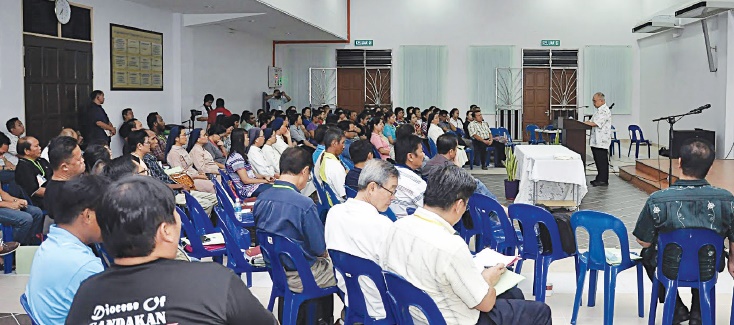Jan 2018
The BEC discerns to discover God in the different events
In the community gathering, news of what is going on in the world ought to be a regular item on the agenda. The gathering ought to be an opportunity to discern those facts in the light of faith. In this way, the news acquires a sense of information and questioning for the community. (The community should not remain at the level of local gossip nor assume a moralistic attitude of lamenting how terrible the times are).
That which makes up the daily life of the people at the work place, etc, that is exploitation and misunderstanding among neighbours, customs regarding death, wedding, birth, lack of hygenic conditions ought also to be the subject of reflection and consideration in the community. This way, the members discover not only how to read the signs of the times and events according to the faith but, principally, how to react to them in a Christian way.
Thus, the BEC gradually understands and explicitates its prophetic mission, discovering God in different events, using his criteria, discerning the values of the Kingdom, and the elements of the anti- Kingdom, that are also present, heeding the call of the Lord to commit oneself, transforming reality with the dynamism of the faith.
This analysis and discernment of reality helps the community to review or establish the options and priorities of action and commitment in the service of the world. It can be done directly or indirectly.
Directly, after analysis and discernment, the community, as a community, commits itself to actions that effect change in the environment. It ought to be an action that involves the community as such and not just the priest or the sister. Effective change in the environment by the community will not always be possible. It is then that the members of the community who, supported by the community, commit themselves personally wherever they live and work to action that effects change in the environment.
The BEC ought to accompany the commitment of its members, helping them to assess and evaluate their work (give them attention, understanding, encouraging them to continue, despite everything). An example of this is cited in Msgr Oscar A. Romero’s Pastoral Letter, “The Mission of the Church in the midst of the crisis of the Country”. (El Salvador 1979):
“It is here, in order to respond to the challenge of this complex situation, that the Church requires a special type of pastoral work (praxis), which we call ‘pastoral accompaniment’ and which breaks with the well-known traditional molds of pastoral for the masses or small groups.’
“I understand pastoral accompaniment or follow-up to be the personal evangelisation of those individuals or groups of Christians who have assumed (taken on) a concrete political option who, according to their consciences, believe that it is the historical commitment of their faith. In this sense, there are many options, charisms and vocations according to the Christian consciences and a pastor ought to respect, discern and orient these consciences according to the light of the Spirit.”
Visible communion with the legitimate Pastors
The visible sign of ecclesial communion is the Bishop in collegiality with the other bishops. Through him, the communion of the Christian communities in the Universal Church takes place and is expressed.
The Bishop shares his responsibility and his mission with those who share his ordained ministry: the priests. These in turn are the link of unity, the visible sign of the union of the Church at the grassroots level with the local Church.
In our experience with the BEC, there is generally no priest among its members. In this new structure at the grass-roots level, the priest is not automatically (not by right or nature) the direct coordinator of each basic cell but, rather, the general coordinator of the other ecclesial ministries at the parish level.
Generally speaking, the parish becomes the locus for organising the solidarity between the BEC, its interrelation with the other levels and sectors of the Church, where resource people are provided to accompany and assess the local coordinators, where certain projects to be participated in jointly are decided upon. As can be seen, the parish gradually evolves to the level of coordination of the different services available at the grass roots level. The diocese is responsible for the broader organisation and coordination of this interchange (communication) of services.
“In fact, it is in the parish that a series of services are taken on that are not able to be assumed by the smaller communities, above all, in the missionary dimension and in the promotion of the dignity of the human person. In this way, the more or less stable emigrants, the marginalised, the outcasts, the non-believers and in general, the more needy, are touched.”
Community integrated and integrating
The BEC is united to the Bishop and to the entire People of God, and is at the same time, the principle of unity among all the baptised and of the Church in history. The BEC seeks also to be the fundamental ecclesial reference for the coming together, convergence and integration of the different movements, associations, groups, etc. affording them the fundamental experience of a basic ecclesial community, besides that of the spiritual or pastoral specialisation according to the finality and specific charism of the movement.
This does not deny the value of and, perhaps, the necessity that the different movements and associations because of their nature, have their own centres of administration and organisation other than at the grass roots level.
The BEC unites in a common mission the many believers who may also “specialise” in movements and associations.
Source: Basic Ecclesial Community: Church from the Roots By Jose Marians and Team, (National Biblical Catechetical and Liturgical Centre, Bangalore, India
Article reproduced from Herald Malaysia online


